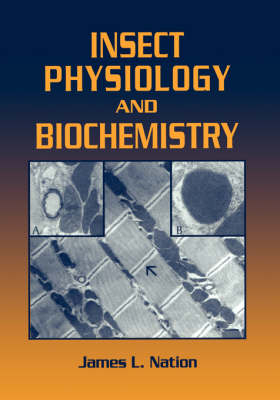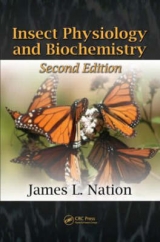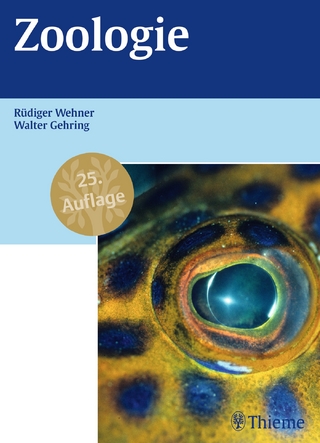
Insect Physiology and Biochemistry
Crc Press Inc (Verlag)
978-0-8493-1181-9 (ISBN)
- Titel erscheint in neuer Auflage
- Artikel merken
Based on nearly 40 years of teaching, this book thoroughly describes the principles and fundamentals of insect physiology. Readers will quickly understand the terminology needed to navigate the voluminous, scattered literature in the field. With approximately 1500 references and more than 240 figures and tables, Insect Physiology and Biochemistry is useful as a core text for upper division and graduate students, as well as a valuable reference for scientists who work with insects in genetics, biochemistry, virology, microbiology, and behavior.
EMBRYOGENESIS
Morphogenesis
Genetic Control of Embryogenesis
Segmentation Genes
Homeotic Genes
Organogenesis
Hatching
Imaginal Discs
DIGESTION
Relationships between Food Habits and Gut Structure and Function
The Major Structural Regions of the Gut
Midgut Cell Types
Microvilli or Brush Border of Midgut Cells
The Glycocalyx
Peritrophic Membranes
Digestive Enzymes
Hormonal Influence on Midgut
Countercurrent Circulation of Midgut and Absorption of Digested Products
The Transepithelial and Oxidation-Reduction Potential of Gut
Gut pH
Digestive System Morphology and Physiology in Major Insect Orders
The Gut as a Potential Target for Population Management of Insects and Control of the Spread of Plant and Animal Disease Organisms
NUTRITION
Importance of Balance in Nutritional Components
Ability of Insects to Self-Select Nutritional Components
Requirements for Specific Nutrients
Techniques and Diets Used in Insect Nutrition Studies
Criteria for Evaluating Nutritional Quality of a Diet
Measures of Food Intake and Utilization
Phagostimulants
Feeding Deterrents
INTEGUMENT
Structure of the Integument
Molting and Formation of New Cuticle
Ecdysis
Sclerotization of Cuticle
Chemical Composition of Cuticle
Mineralization of Insect Cuticles
Capture of Atmospheric Water on Cuticular Surfaces
HORMONES and DEVELOPMENT
Historical Beginnings for the Concept of Hormonal Control of Molting and Metamorphosis
The Interplay of PTTH, Ecdysteroids, and Juvenile Hormone Controls Development
Brain Neurosecretory Cells and Prothoracicotropic Hormone: PTTH
The Prothoracic Glands and Ecdysteroids
The Corpora Allata and Juvenile Hormone
Mode of Action of Ecdysteroids at the Gene Level
A possible Timer Gene in the Molting Process
Ecdysone-Gene Interaction Ideas Stimulated Vertebrate Work
INTERMEDIARY METABOLISM
The Energy Demands for Insect Flight
Metabolic Stores
Hormones Controlling Carbohydrate Metabolism
Pathways of Metabolism Supporting Intense Muscular Activity Such as Flight
NEUROANATOMY
The Central Nervous System (CNS)
The Brain
Ventral Ganglia
Oxygen and Glucose Supply to the Brain and Ganglia
The Neuropil
Hemolymph-Brain (CNS) Barrier
Neurons: The Building Blocks of a Nervous System
Giant Axons in Insect Central System
Nervous System Control of Behavior: Motor Programs
Neurosecretion Products from the CNS
NEUROPHYSIOLOGY
Nerve Cell Responses to Stimuli
The Physiological Basis for Neuronal Responses to Stimuli
Conduction of the Action Potential: The Local Circuit Theory
Physiology and Biochemistry at the Synapse: Excitatory and Inhibitory PostSynaptic Potentials
Acetylcholine Mediated Synapses
Electric Transmission across Synapses
Neuromuscular Junctions
MUSCLES
Basic Muscle Structure and Function
Synchronous and Asynchronous Muscles
Muscle Proteins and Physiology of Contraction
Thoracic Structure, Wing Hinges, and Muscle Groups Involved in Flight
Muscles Involved in Jumping
Sound Production : Tymbal and Stridulatory Muscles
Morphology and Physiology of Non-Skeletal Muscle
SENSORY SYSTEMS
External and Internal Receptors Monitor the Environment
General Functional Classification of Sensory Receptors
Mechanoreceptors
Chemoreceptors
Light and Visual Receptors
CIRCULATORY SYSTEM
Introduction: Embryogenesis of the Circulatory System and Hemocytes
The Dorsal Vessel: Heart and Aorta
Accessory Pulsatile Hearts
Hemocytes
The Hemolymph
The Rate of Circulation
Hemoglobin in a Few Insects
RESPIRATION
Structure of the Tracheal System
Tracheal Supply to Tissues and Organs
Ventilation and Diffusion of Gases within the System
Discontinuous Gas Exchange Cycle
Water Balance during Flight
Gas Exchange in Aquatic Insects
Respiration in Endoparasitic Insects
Respiratory Pigments
Respiration in Eggs and Developing Embryos
Non respiratory Functions of the Tracheal System
EXCRETION
The Malpighian Tubules
Ultrastructure of Malpighian Tubule Cells
Formation of Primary Urine in Malpighian Tubules
A Proton Pump is the Driving Mechanism for Urine Formation
Selective Reabsorption in the Hindgut
The Role of the Excretory System in Maintaining Homeostasis
Cryptonephridial Systems
PHEROMONES
Classes of Semiochemicals
Importance of the Olfactory Sense in Insects
The Active Space Concept
Pheromones Classified According to Behavior Elicited
Pheromone Parsimony
Chemical Characteristics of Pheromones
Insect Receptors and the Detection Process
Information Coding and Processing
Geographical and Populational Differences and Evolution of Pheromone Blends
Hormonal Control of Pheromone Synthesis and Release
Biosynthesis of Pheromones
Practical Applications of Pheromones
REPRODUCTION
Female Reproductive System
Vitellogenins and Yolk Proteins
Sequestering of Vitellogenins and Yolk Proteins by Oocytes
Formation of the Vitelline Membrane
The Chorion
Gas Exchange in Eggs
Male Reproductive System
Sex Determination
| Erscheint lt. Verlag | 28.11.2001 |
|---|---|
| Zusatzinfo | 240 Illustrations, black and white |
| Verlagsort | Bosa Roca |
| Sprache | englisch |
| Maße | 178 x 254 mm |
| Gewicht | 1066 g |
| Themenwelt | Naturwissenschaften ► Biologie ► Zoologie |
| ISBN-10 | 0-8493-1181-0 / 0849311810 |
| ISBN-13 | 978-0-8493-1181-9 / 9780849311819 |
| Zustand | Neuware |
| Informationen gemäß Produktsicherheitsverordnung (GPSR) | |
| Haben Sie eine Frage zum Produkt? |
aus dem Bereich



